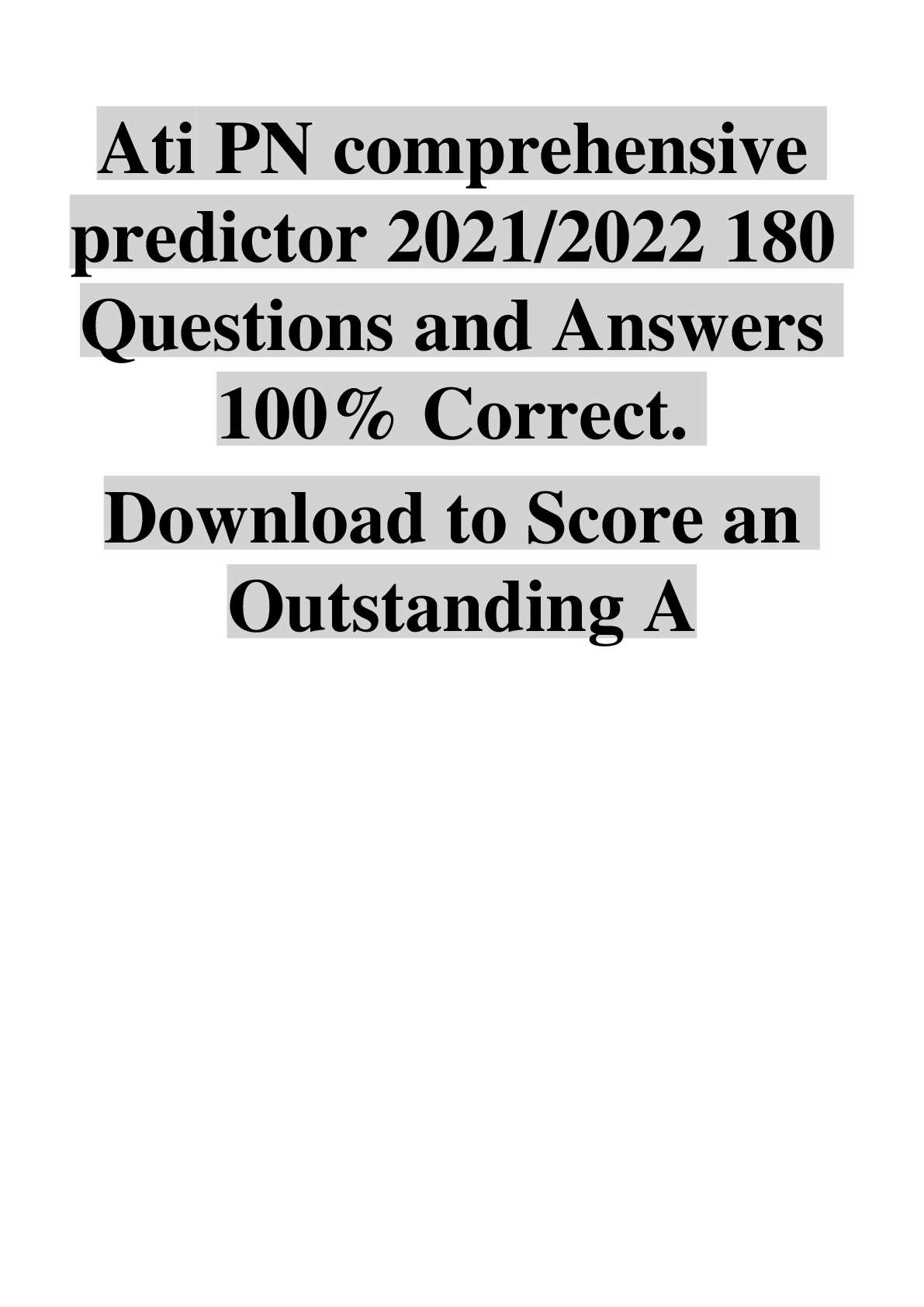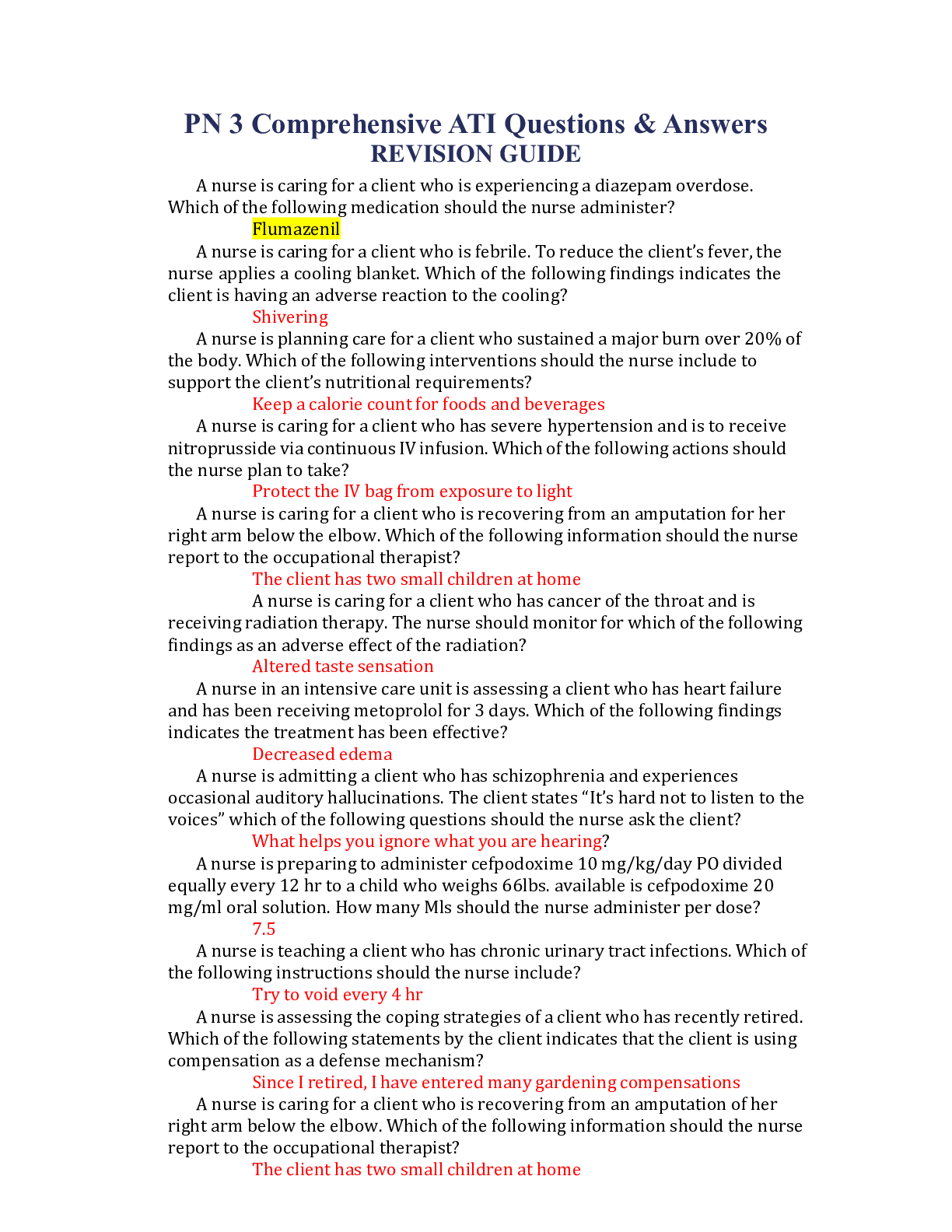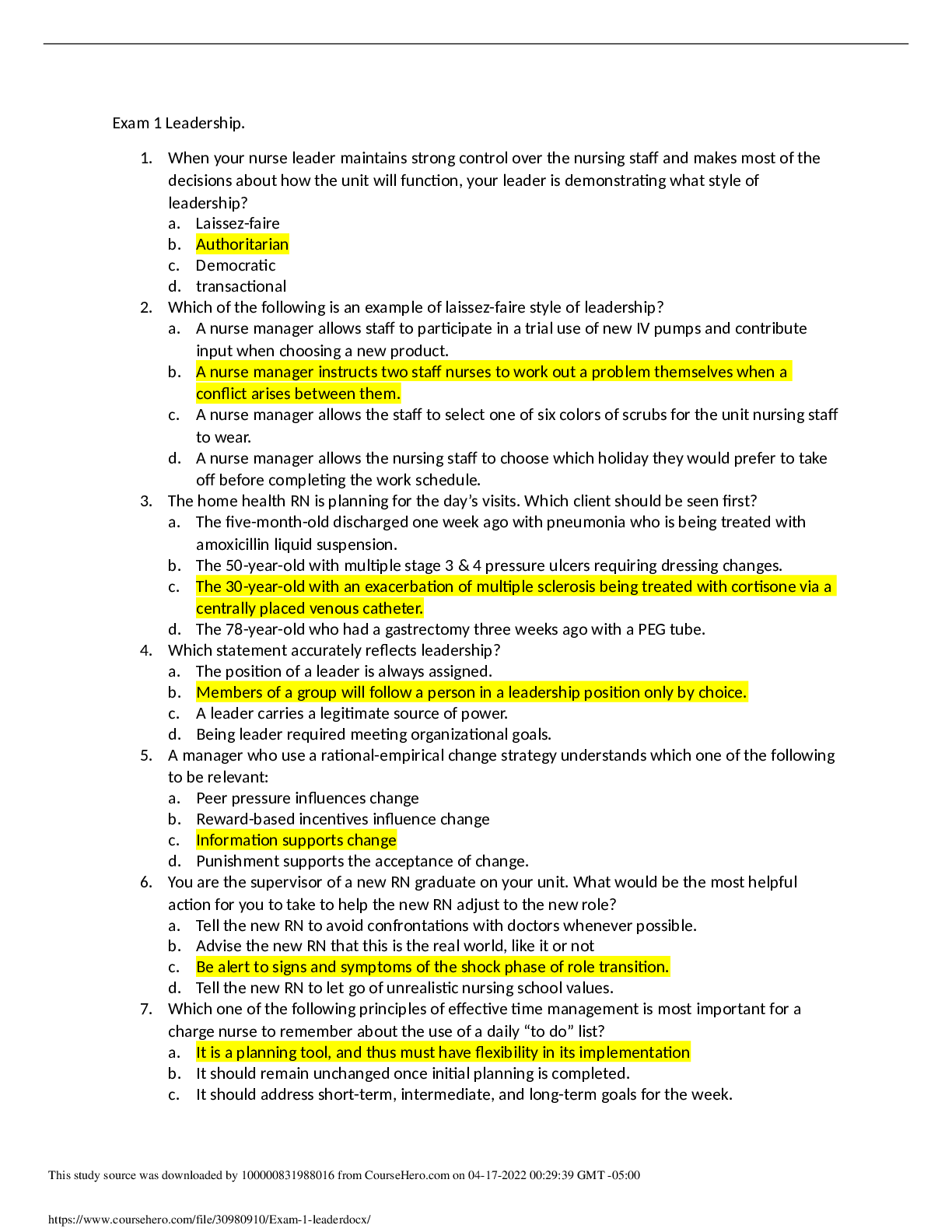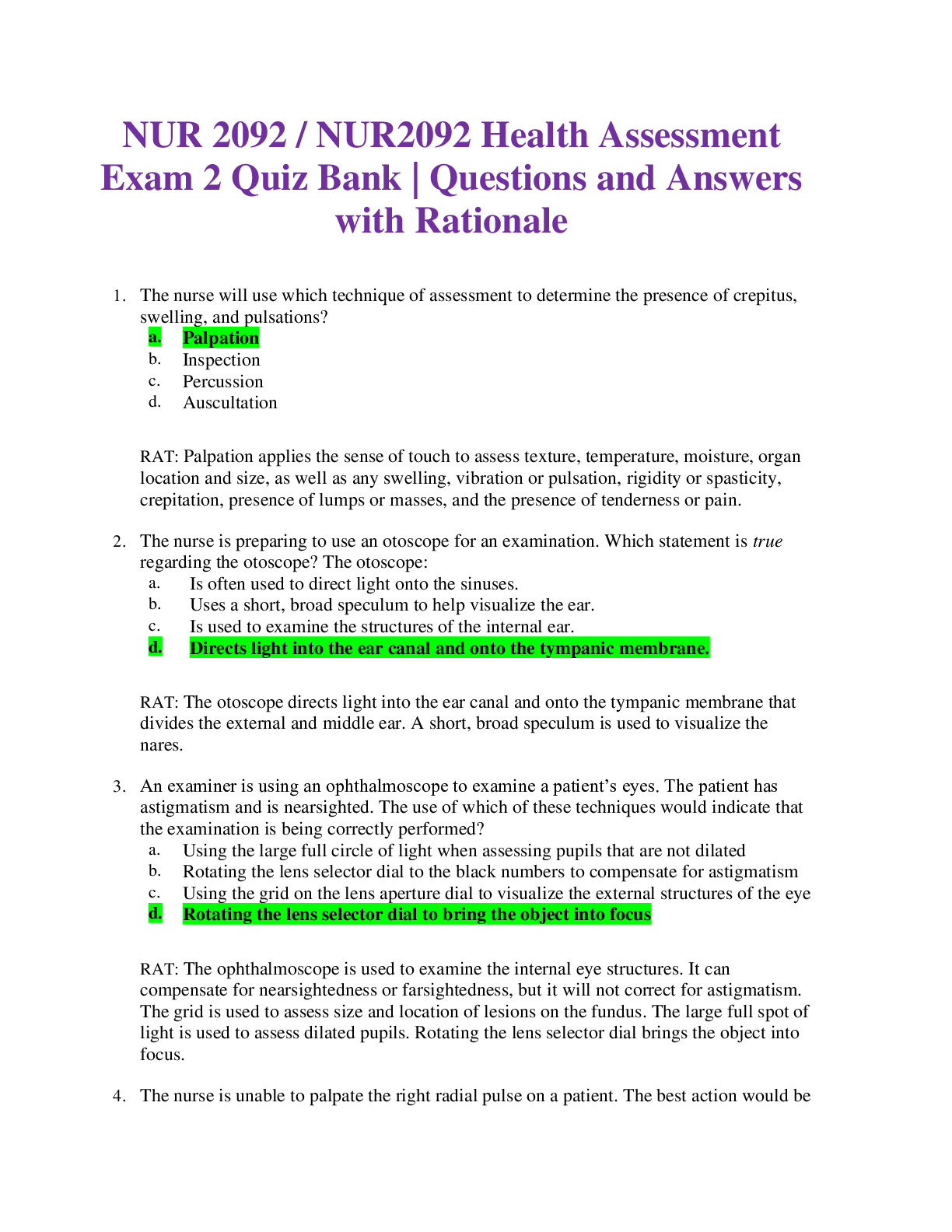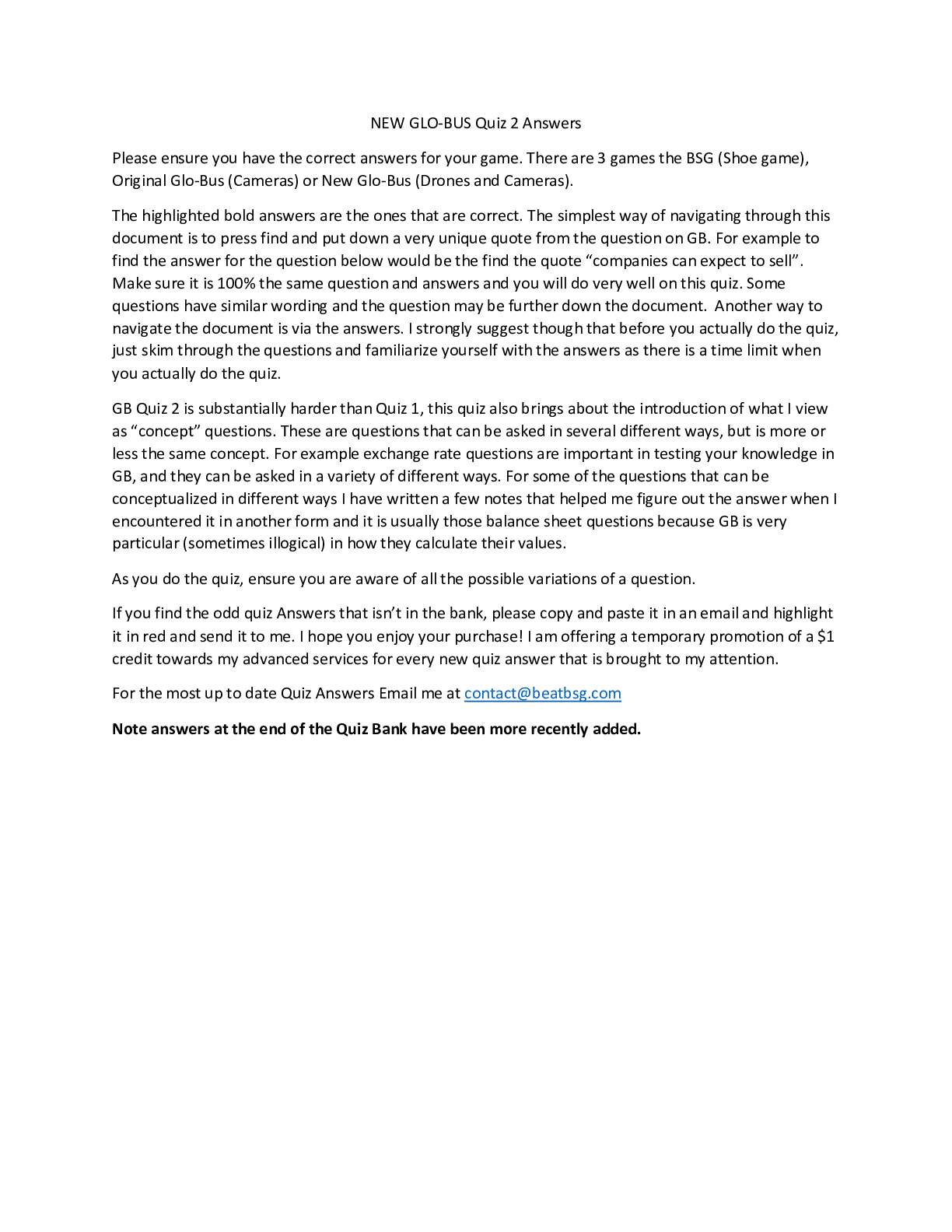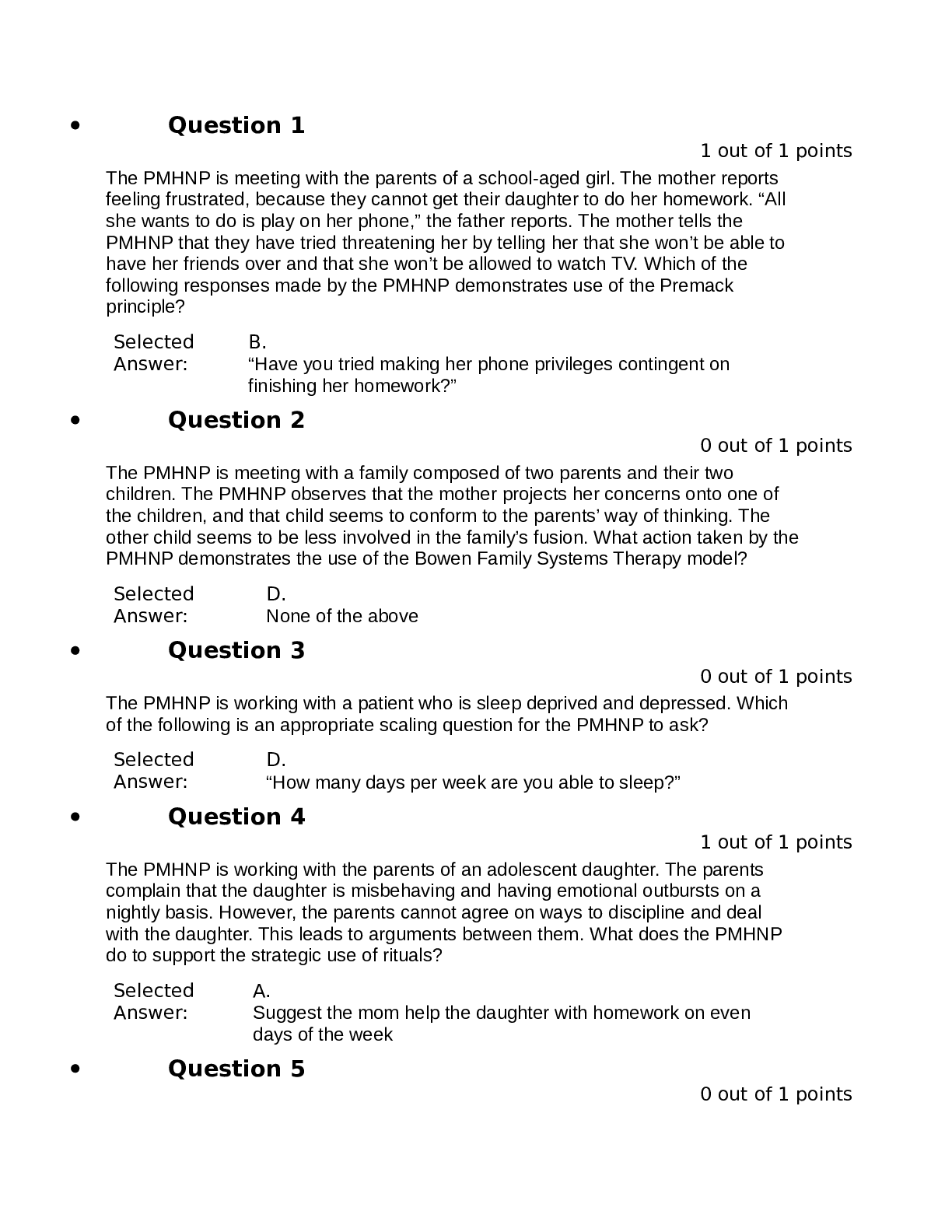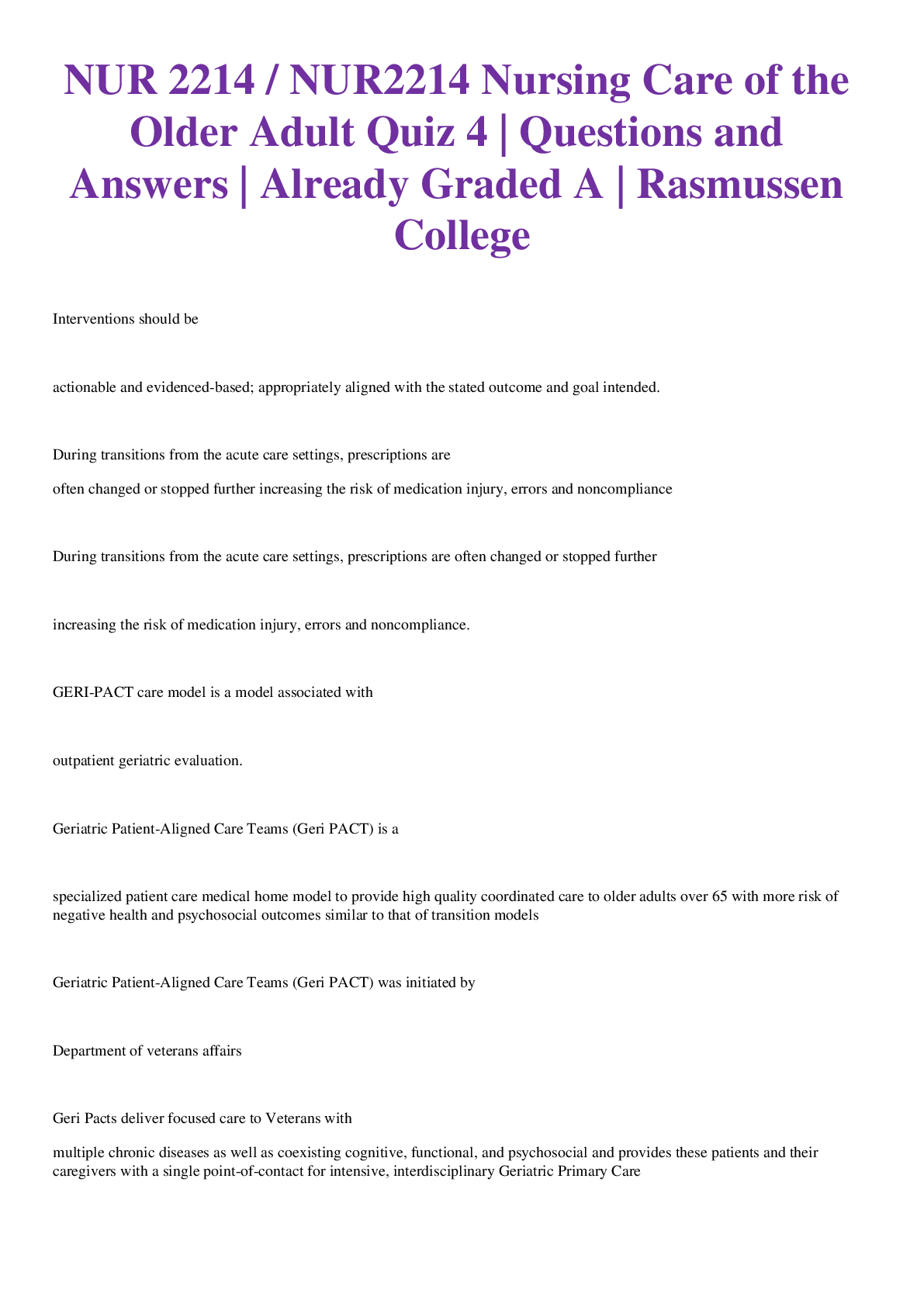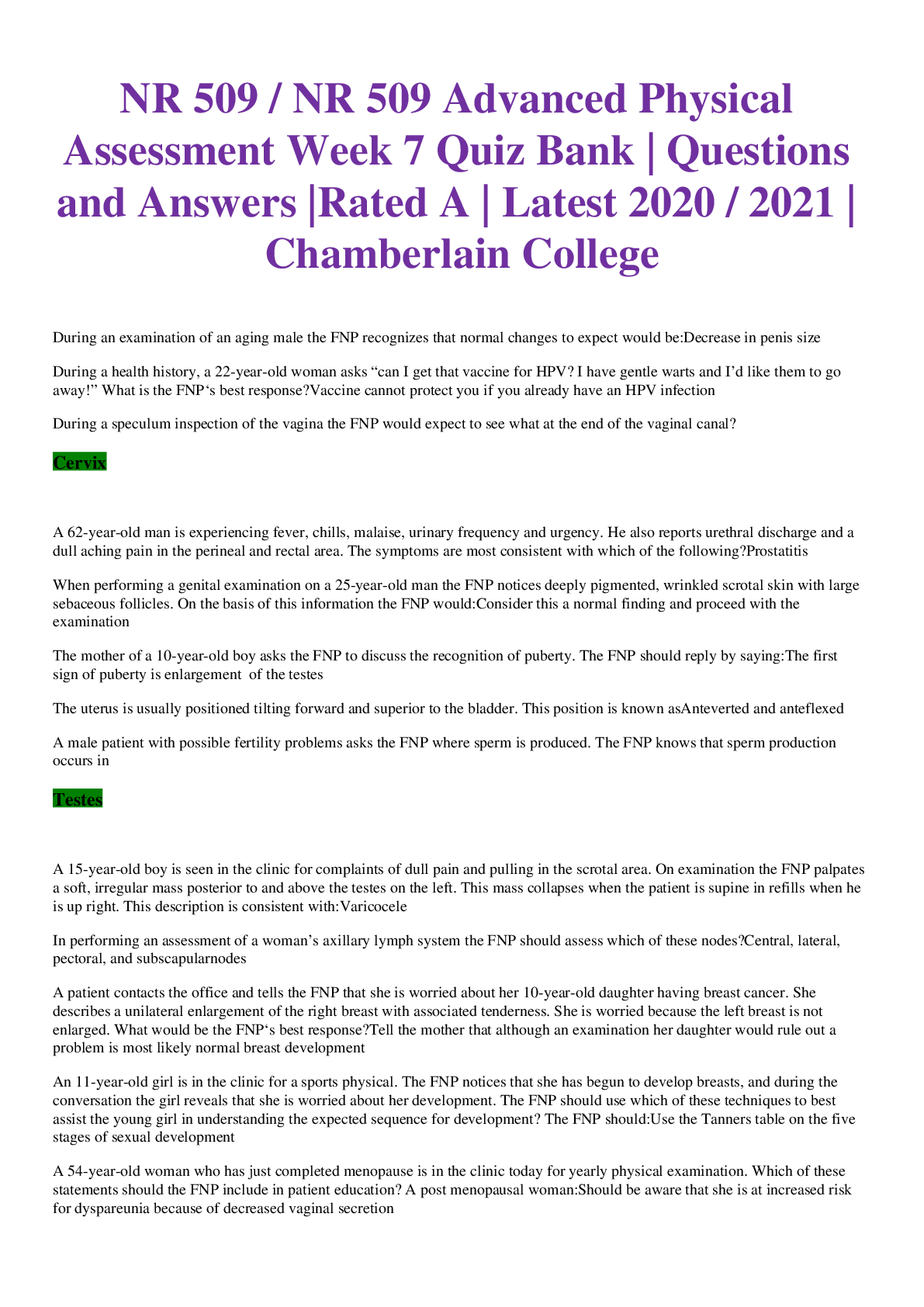*NURSING > EXAM > PSYC 290N Week 2 Infancy Quiz (VOLUME 1) | Questions and Answers elaborations | Download To Score An (All)
PSYC 290N Week 2 Infancy Quiz (VOLUME 1) | Questions and Answers elaborations | Download To Score An A
Document Content and Description Below
Week 2 : Infancy - Quiz 13432976 http://takeexam.n en-US Time Remaining: 140054989 79202498 1 False false rldbqn=1 MultipleSections NavigateFreely False 0 0 /main/CourseMod Q 1.... 1. (TCOs 3 & 5) What is the name of the process of creating new synapses that happens very quickly in the first couple of years after birth? (Points : 2) Synaptic pruning Synaptomiosis Myelinization Synaptogenesis 0 1413700831 MultipleChoice 1 Q 2. 2. (TCOs 3 & 5) What effect does watching television have on the developing brain? (Points : 2) Any television watching prior to age 2 is likely to inhibit healthy brain development. Toddlers might improve their vocabulary & social skills by watching high-quality television programs. Television programs such as Sesame Street can interfere with synaptogenesis. The American Academy of Pediatrics recommends that children between 18 months & 2 years of age watch 2–3 hours per day of educational programming. 0 1413700832 MultipleChoice 4 Q 3. 3. (TCOs 3 & 5) An infant's sleep/wake cycle lasts approximately how long? (Points : 2) 30 to 45 minutes 4–6 hours 2 hours 8 hours 0 1413700833 MultipleChoice 7 Q 4. 4. (TCOs 3 & 5) Lilly has just learned to walk backward. How old would you expect Lilly to be? (Points : 2) Between 10 & 12 months Between 13 & 18 months Between 19 & 24 months At least 2 years old 0 1413700834 MultipleChoice 12 Q 5. 5. (TCOs 3 & 5) With regard to breastfeeding, which statement is correct? (Points : 2) Breastfeeding facilitates the development of superior social interactions between mother & child. Breast milk provides antibodies to protect infants against diseases, such as gastrointestinal & upper respiratory tract infections. Human breast milk does not appear to promote the growth of nerves or development of the intestinal tract. Breastfeeding meets the nutritional needs of relatively few infants. 0 1413700835 MultipleChoice 13 Q 6. 6. (TCOs 3 & 5) Amy is 3 years old & has 20/40 vision. What does this mean? (Points : 2) Amy’s visual acuity is average for a 3-year-old. In order for Amy to see an object, she has to be 20 ft away from it, whereas most people can see the object from 40 ft away. Amy is considered legally blind. In order for Amy to see an object, she has to be 40 ft away from it, whereas most people can see the object from 20 ft away. 0 1413700836 MultipleChoice 16 Q 7. 7. (TCOs 3 & 5) Elisa is growing up in a home where both Russian & English are spoken. Which of the following statements is most likely true of 7-month-old Elisa? (Points : 2) She will be confused by the mixture of languages & will be delayed in her ability to distinguish contrasting sounds. She can accurately discriminate all sound contrasts that appear in both languages. She will respond to all sounds in the same way. She will be able to respond to distinctions in sounds when her mother speaks, but not when her father or male siblings speak. 0 1413700837 MultipleChoice 20 Q 8. 8. (TCOs 3 & 5) Glynnis is 14 months old. She is trying out new things, playing with her toys, & manipulating objects in new ways—experimenting with her environment. Glynnis is in which substage of Piaget's first cognitive stage? (Points : 2) Primary reflexes Primary circular reactions Tertiary circular reactions Mental representation 0 1413700838 MultipleChoice 23 Q 9. 9. (TCOs 3 & 5) Which of the following terms is used to describe a strategy in which researchers move an object in a way that the infant does not expect? (Points : 2) Violation of object permanence method Violation-of-expectations method Violation of object concept method Violation of experience method 0 1413700839 MultipleChoice 26 Q 10. 10. (TCOs 3 & 5) Brody is entertaining himself & his mother with his repetitious "dadadada, babababa" as if he just likes the sound of his own voice. What is Brody doing? (Points : 2) Babbling Cooing Muttering Recasting 0 1413700840 MultipleChoice 30 Q 11. 11. (TCOs 3 & 5) Derek saw his mother's hat & exclaimed, "Mommy!" This is an example of which of the following? (Points : 2) Telegraphic speech A holophrase Dual meaning Compound meaning 0 1413700841 MultipleChoice 31 Q 12. 12. (TCOs 3 & 5) Morgan does not seem to underst& what is said to her or around her nearly as well as her playmates. Based on your reading, what else might we assume about Morgan's development? (Points : 2) Morgan had poorly developed gross motor skills. Morgan is probably a late talker. Morgan has poorly developed fine motor skills. Morgan will probably not be particularly creative. 0 1413700842 MultipleChoice 34 Q 13. 13. (TCOs 3 & 5) According to your text, some researchers suspect that among infants, which of the following might be a good predictor of later intelligence test scores? (Points : 2) Types of object permanence Rates of habituation Levels of accommodation Referential language 0 1413700843 MultipleChoice 39 Q 14. 14. (TCOs 3 & 5) Which of the following best defines intelligence? (Points : 2) The ability to rapidly solve problems The ability to use information & solve problems across a variety of cultures The ability to take in & use information to function within a particular environment The ability to function well within one's family 0 1413700844 MultipleChoice 40 Q 15. 15. (TCOs 3 & 5) According to Bowlby's theory of attachment, which of the following will a child have developed by age 5 years? (Points : 2) An internal model that includes self, mother, & relationships in general An external model that includes self, mother, & relationships in general An internal model that includes only self & the primary caregiver An internal model that includes self, & mother, but excludes a model of the father 0 1413700845 MultipleChoice 43 Q 16. 16. (TCOs 3 & 5) Callie, age 11 months, went to the circus with her mother. When a clown came bouncing up to Callie's stroller, Callie was anxious & looked at her mother. When Callie's mother began to laugh at the clown, Callie joined in the laughter. Callie's behavior is called (Points : 2) affective regulation. social referencing. stranger anxiety. bonding dependence. 0 1413700846 MultipleChoice 47 Q 17. 17. (TCOs 3 & 5) Your neighbor Sarah told you that her two children were obviously very different & it was noticeable right from birth. According to Sarah, her son was fussy & rarely slept through the night, but her daughter was calm & adapted very easily to any situation. Sarah is describing which aspect of her children's differing personalities? (Points : 2) Attachment pattern Patterns of sociability Temperament Mood 0 1413700847 MultipleChoice 51 Q 18. 18. (TCOs 3 & 5) At what age do self-conscious emotions typically arise? (Points : 2) 18 months 30 months 34 months 36 months 0 1413700848 MultipleChoice 54 Q 19. 19. (TCOs 3 & 5) Which of the following statements about social development & day care is true? (Points : 2) Children in nonparental care seem to have a higher rate of insecure attachment than children with exclusively maternal care. Children in nonparental care show no substantive differences in attachment from children cared for exclusively by their parents. There is a heightened risk of insecure attachment in children placed in day care after the age of 1. Parental behaviors are more associated with social development if the day care arrangements are unstable. 0 1413700849 MultipleChoice 57 Q 20. 20. (TCOs 3 & 5) Jaslin is a caregiver in a local day care. Parents often describe her as involved, positive, & responsive to the children. Jaslin would be defined as what type of caregiver? (Points : 2) Sympathetic Knowledgeable Well organized Sensitive 0 1413700850 MultipleChoice 60 Q 21. 21. (TCOs 3 & 5) Describe where the United States st&s in relation to other countries in terms of securely attached infants. Give your informed & educated opinion as to why the U.S. st&s where it does statistically. (Points : 10) In the United States research has indicated that once an infant has become securely attached to an adult that they are more likely to be a securely attached child. Although when looking at the Strange Situation experiment, it is shown that no two children are alike. For example one child that separates from their caregiver may cry, whereas another securely attached infant may not. Each child has the own response to the situation. In the Stranger situation experiment, a child between ages 12 & 18 months is observed in multiple scenarios. These consist of, with the mother, with the mother & a stranger, alone with a stranger, completely alone for a few minutes, reunited with their mother, alone again, with the stranger again, & finally reunited with their mother. The experiment must be done in this order & how the child responds in each situation is what classifies the child with a secure attachment, an insecure/avoidant attachment, insecure/ambivalent attachment, & an insecure/disorganized attachment. Child attachment has also been researched by looking at two-parent homes & families with different ethnicity. Statistics show us that a little over 60% of all children live with both of their biological parents. Now does this mean that a child with a two-parent household won't be a securely attached infant? No, because each child responds differently & no two children are the same when looked at through the Stranger Situation experiment. Reference: References: Boyd, Denise, Helen Bee. Lifespan Development, 7th Edition. Pearson Learning Solutions, 03/2014. Pgs 132-135, 195-202. VitalBook file [Show More]
Last updated: 1 year ago
Preview 1 out of 6 pages

Also available in bundle (2)

PSYC 290N Entire Course Week 1 – 8 BUNDLE | Highly RATED Documents | 100% Correct Solutions.
PSYC 290N Week 1 Quiz – Based Homework PSYC-290N Week 1 Graded Discussion Topic 1 PSYC 290N Week 1 Graded Discussion Topic 2 PSYC-290N Week 2 Course Project I: My Virtual Life – Raise A Child: Sect...
By A+ Solutions 2 years ago
$14.5
21

PSYC 290N Week 2 Infancy Quiz (Collection)
PSYC 290N Week 2 Infancy Quiz (Collection)
By A+ Solutions 2 years ago
$14.5
3
Reviews( 0 )
Document information
Connected school, study & course
About the document
Uploaded On
Apr 19, 2022
Number of pages
6
Written in
Additional information
This document has been written for:
Uploaded
Apr 19, 2022
Downloads
0
Views
51






.png)










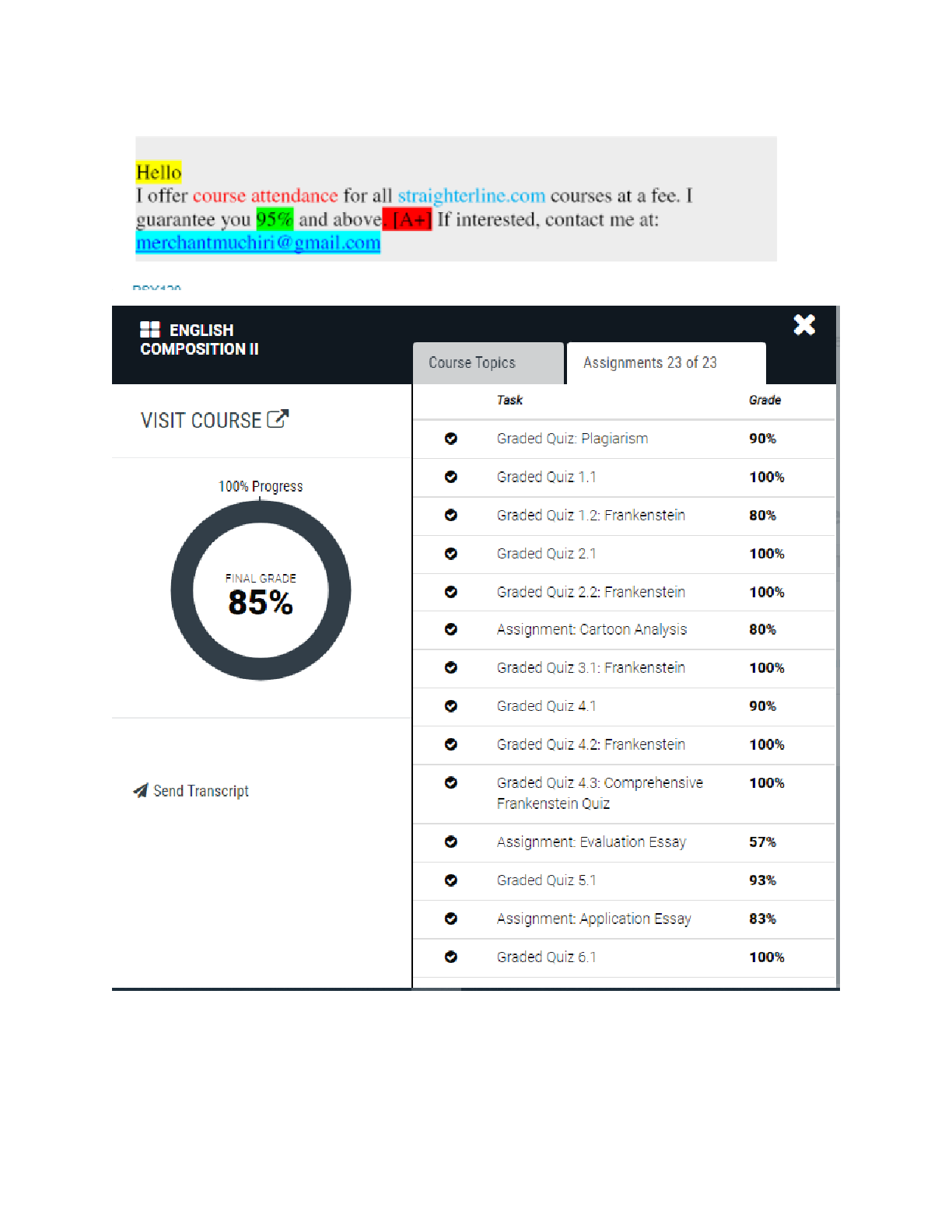

.png)



